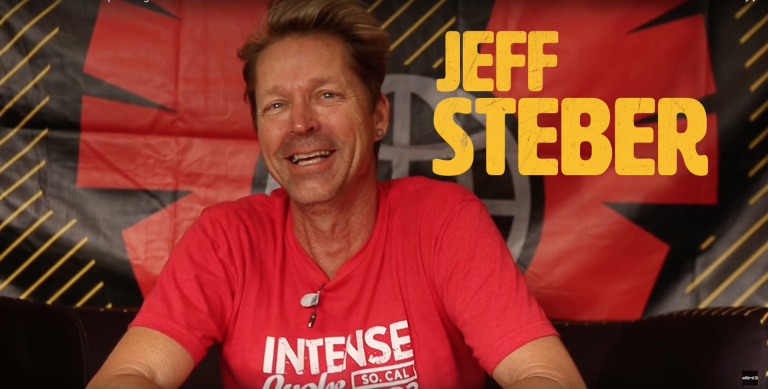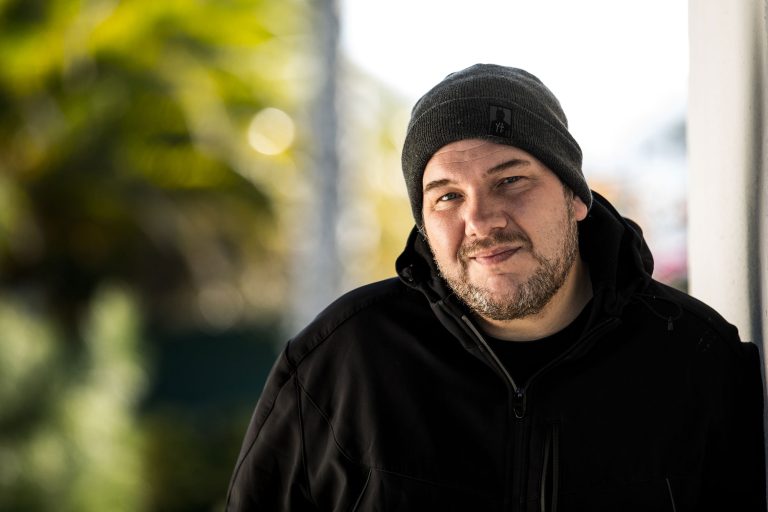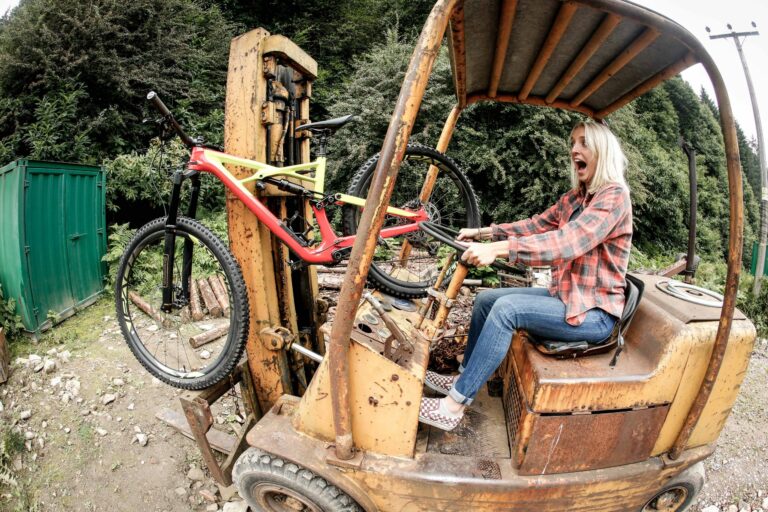Luis Arriaz: Not Enough, I think is because it is so difficult to understand what the majority of the shocks adjustments do as well as to what the bike and its suspension is doing. I believe that marketing hype is the main cause of people not knowing what to do with your suspension because they have been somewhat misinformed.
What are your views on frame designs and how have they influenced the making of your own K–9 industries bikes?
Frame design is an interesting topic. Let’s assume we are talking about downhill bikes, in which case the frame most likely will be made of aluminium. You can employ several different techniques; people have been using mainly tubular frames, monocoque, and now castings. Along with these types of frames you can use the following processes; extrusions, hydroforming, forgings and CNC machining.
Our prototypes have been manufactured using extruded Easton tubing and CNC machining of components where loading was found to be high. For the production bikes we will be utilizing Reynolds tubing, they will make some custom extruded tubes to our specifications in an effort to reduce the overall mass of the bike and to provide a unique look of the bikes. I am a fan of the triangulated frames which have an uninterrupted seat tube, you can lose a lot of stiffness without it and it just doesn’t look right.
We looked as hydro forming but at the end of the day it is heavier than mechanical extrusions because you cannot precisely control the flow rate and you have to allow for minimum thickness, sure you can achieve great shapes. We have also been looking at monocoque style of frames (Oranges, GT DHi and Intense M3) and you can get some seriously light bikes but at the moment the economics for this technique and the scale of production does not allow us to do so.
I am very interested to see if the guys from Empire can get their cast bike in to production, with this technique you have to be very careful with internal voids, air pockets and mainly fatigue life, but I am sure it could be done, the technology is already available from motorsports and there are a lot of very capable companies in the UK that can do the castings.
Explain a bit more about instant centre.
To talk about instant centre it is best to talk about single pivots an its location, this has a great effect on the behaviour of the bike and I am not just talking about axle path and chain lengths growth, I am talking about how this point dictates how much the bike will squat under acceleration and in cornering.
The Instant Centre (I.C.) is basically the intersection of projected linkage arms and it is the point at which the wheel rotates or pivots. This point is constantly moving as the suspension moves and if designed correctly this can be used to control the behaviour of the bikes. On some rear suspension designs the I.C. moves quite a lot and on some it moves in an undesirable way, the beauty of the single pivot is that is does not move.
If you think about it, on race cars it is used to control the movement of the wheels due to bump, control the camber change and roll angle and roll axis during cornering, as well as the anti squat and anti dive characteristics of said vehicle. On bikes we are mainly asking to control the axle path, pedal efficiency and anti squat, which is a lot less things to control.
What are your views on axle paths? Do they matter?Luis Arriaz: Yes they do, because they affect how the suspension will move due to an impact as well as dynamic balance of the vehicle (bike) and its stability. But I would not sacrifice excessive chain length growth in order to achieve a very rearward axle path. Ideally you would like the rear axle path to be perfectly parallel to the front axle path without affecting the chain length growth, this is very difficult to achieve, but we are very close to it with the L.A. Link, and we are getting closer as we speak.
You have a business partner, Shinny? What has he brought to the business?
Shinny (Shinshu Tanaka) is a very good friend of mine from Oxford Brookes University; he is a thrid year mechanical engineering student and a race car driver that competed last year in Spain at the Master Junior Formula. I help him at a few races guiding him with the data, driving style and car set up.
To K–9 he is an invaluable asset, he is very good at 3D modelling and designs as well as animations. At the moment we are creating a complete CAD library of all the components we will be using on the bike which will facilitate the design of the final production bike. He has brought his professionalism in racing, dealing with sponsors, nutrition, appearance, mental preparation that helps the young riders we are sponsoring; he acts as their guide and manager.
Tell us a bit more about the data acquisition you have been using. How easy/difficult has it been interpreting the data?
Well funny you ask, because we have two systems at the moment. The first is a very basic system that can only measure the suspension performance. It is good at measuring sag, suspension displacements and velocities, and it is very useful for basic set up, but it does not record speed, distance, accelerations, which is something I want to see in order to get a better understanding of what the suspension is doing and why.
We are also using a very sophisticated data logging from an Italian company; this system is used in several race car teams, motocross, etc. This is a very complex system and we are learning more and more about what we can do with it every day. For instance, with this system we can measure just about anything we wish to measure. At the moment we are monitoring suspension performance, crank rotation (pedalling) and its effect on the suspension, accelerations in all three axis, which we can use to see accelerations due to braking, cornering and jumps, bumps, etc. We also have a GPS antenna that plots the track very accurately and divides it into sectors and compares performance from multiple runs, we can also see what is happening at each point of the track. We will be offering data logging services to teams and individuals if we find there is a demand for it to help set up and improve the performance of the bikes and riders.
And the GPS…many times more powerful than standard ‘shop bought’ models? Is that one of Shinni’s strong points, GPS?
Yeah I would think so, the GPS data logger we are utilizing has a receiver that can record up 500 Hertz, and I am not too sure about ‘shop bought’ models but I would not think it is over 10–25 Hertz. The unit we are using needs to be very precise to be used in motorsports. Shinny is very good when it comes to reading and analysing data, he has been around it as a race car driver and now as an engineer.
OK, talk about your bike for a minute. Having ridden it, the rear suspension is very, very good. How did you arrive at that design?
Thanks, I appreciate you like it because I know that in theory it should work and from testing we can see the potential, but is reassuring to see that someone with a lot more experience than me can appreciate the way it performs. A long story made short, I was in the market for a downhill bike and could not make up my mind as to what to get. It was then that I realized that most designs offer some kind of trade off of some sort, pedal efficiency vs. small bump sensitivity, and realized that most systems try to solve the problems found on previous designs. Why?
So I decide to start applying my new found knowledge of kinematics and vehicle dynamics on a new rear suspension design that does not compromise suspension performance, pedal efficiency and behaviour of the bike. Starting with a clean sheet, it gave me the freedom to ask myself what do I want the bike to do, what is the best case scenario, and how can I achieve it. Rather than trying to modify a pre–existing design to improve its pedal efficiency or create a vertical axle path or use low speed compression to sacrifice small bump sensitivity for improve pedalling.
You can be surprised with what you can achieve when you search for something different, because you asked yourself some very different questions. When I started to design the bikes I was mainly influence by what I wanted the bike to do rather than characteristics found on other bikes. For instance I wanted the bike to have a constant wheelbase, so it remains very stable as using a rear axle path is parallel to the front axle, which also helps on the square edge hits as it does not lose as much momentum. I also wanted the motion ratio and compression ratio to be linearly progressive so that it would give very good small bump sensitivity while providing enough suspension on bigger hits. I also wanted to separate the pedalling forces from the suspension movement and vice versa, greatly reducing pedal kickback and pedal induced bob without resorting to some very stiff low speed compression (that’s just wrong). I really wanted to control the anti squat characteristics so the bike would not squat under acceleration or in G–outs.
What are the plans for K–9?Luis Arriaz: This is a very exciting time for us. In less than a year we have designed and manufactured our first four prototypes, filed a patent and done extensive testing on the suspension and the bikes, and we are very pleased with the results so far.
So for this year we will finish the testing period, address the key areas that have needed attention (weight, mud clearance), fine tune the geometry even more and have the production downhill bikes ready for the summer. And we will be developing a 6” travel bike and a 4” 4X and Slopestyle bike to hit the market before the end of the year. We will also be attending several races this year with our prototypes and giving our young riders as much support as possible, but we are also looking for elite riders to race our bikes and further help the development process.
We will be at The National Bike Show to display our prototypes and let people know about our other products and services: data logging, suspension licensing, etc. We are still looking for distributors for our bikes which will be manufactured in limited production volumes; everything will be done 100 % in the UK. We are looking to do several projects based around the bikes with Oxford Brookes University.
Dirt was lucky to be able to spend several days with Luis and his new bikes, and although he is still at the development stage it looks very promising, with a design that really translates to grip on the hill. Ladies and gentlemen, Luis Arriaz.





